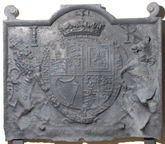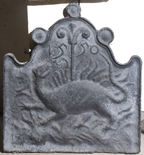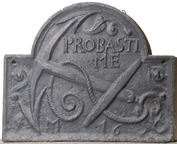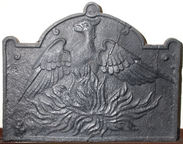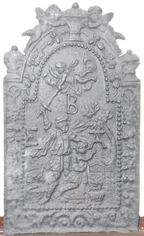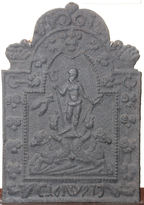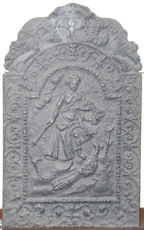-
406
Description: Arched rectangular shaped; convex moulding (top and sides surviving); scrolled protrusions above top corners; Stuart royal shield, crown, garter, supporters and motto; initials separated by crown.
Notes: The scrolled protrusions suggest a possible association with other firebacks with similar features. The Stuart arms in the same style are seen on another fireback (no. 1036).
Inscription: I R / HONI SOIT QVI MAL Y PENSE
Arms: English Stuart royal - James I
- Decoration tags:
- rectangular with round arch (shape)
- convex (edging)
- whole carved pattern
- armorial
- royal
- text
Manufactured: in the early-17th century possibly in the Weald area of England.
Current location: Anne of Cleves House, Southover High Street, Lewes, East Sussex, England.
Museum number: LH000.944 (part of the Sussex Archaeological Society museum group)
-
407
Description: Quasi-arched rectangular shaped; unique, cavetto moulded edging, which loops upon itself three times. A mythical salamander shown in the flames which legend states it is able to resist; behind is what appears to be a palm tree, on either side of which the date is stamped.
Notes: The fireback has been incorrectly dated 1550 instead of 1650, which Schubert, following W. R. Lethaby, asserted was a forgery claiming indications that a ‘6’ had been erased. Undoubtedly the first '5' is more prominent than the other figures though the exact method by which it has been substituted is not clear. Corrosion to the bottom right corner may have obliterated a letter 'M' seen on another casting; presumably part of 'IM'.
Inscription: 1550
- Decoration tags:
- rectangular with ornate arch (shape)
- cavetto (edging)
- whole carved pattern
- individual numbers
- pictorial
- mythological
- text
- animals
Manufactured: in 1650 possibly at Brede Furnace in the Weald area of England.
Current location: Anne of Cleves House, Southover High Street, Lewes, East Sussex, England.
Museum number: LH000.901 (part of the Sussex Archaeological Society museum group)
Citation: Dawson, C., 1903, 'Sussex Iron Work and Pottery', Sussex Archaeological Collections, 46, pp. 1-54.
Citation: Gardner, J. S., 1898, 'Iron Casting in the Weald', Archaeologia, 56, 1, pp. 133-164.
Citation: Lethaby, W. R., 1 Oct 1926, 'English Cast Iron - I', The Builder, 131, no. 4365, pp. 537-8.
Citation: Schubert, H. R., 1957, 'A Forgery in Iron', Journal of the Iron & Steel Institute, 165, p. 125.
- Attached to series:
- Hooked '1' series
- Loop edged firebacks
- Brede group
-
408
Description: Arched rectangular shape; cavetto moulded edge all round; holes pierced in top corners; a fouled anchor with one fluke resting on the base, a scroll below each top corner, foliage above the text, which is above the anchor; the initials either side of the lower fluke.
Notes: The inscription is a quotation from Psalms 139, v. 1: ‘Domine, probasti me et cognovisti me’ (Lord, thou hast searched me and known me).
Copies of this fireback are known.
Inscription: PROBASTI / ME / I M 16 5[0?]
- Decoration tags:
- rectangular with round arch (shape)
- cavetto (edging)
- whole carved pattern
- individual numbers
- planklines
- pictorial
- biblical
- text
- objects
Manufactured: in the mid-17th century possibly at Brede Furnace in the Weald area of England.
Current location: Anne of Cleves House, Southover High Street, Lewes, East Sussex, England.
Museum number: LH000.908 (part of the Sussex Archaeological Society museum group)
Citation: Dawson, C., 1903, 'Sussex Iron Work and Pottery', Sussex Archaeological Collections, 46, pp. 1-54.
-
409
Description: Quasi-arched rectangular shape, semi-circular protrusions on top corners; circular loop at top of arch; fillet edging with small twists inside arch, and curls inside and below top corners; a phoenix in flames, its wings displayed and inverted.
Notes: The use of the loop in the edging draws comparisons with other firebacks, and may indicate the same source. Formerly part of the J. H. Every collection.
- Decoration tags:
- rectangular with round arch (shape)
- fillet (edging)
- whole carved pattern
- planklines
- pictorial
- mythological
- animals
Manufactured: in the mid- to late-17th century possibly in the Weald area of England.
Current location: Anne of Cleves House, Southover High Street, Lewes, e, England.
Museum number: 1944.24.061 (part of the Sussex Archaeological Society museum group)
- Attached to series:
- Loop edged firebacks
- Phoenix firebacks
-
413
Description: Arched rectangular central panel with bead edging; standing figure of Abraham about to sacrifice a kneeling Isaac, Abraham's raised right hand holding a sword is retrained by an angel; behind Abraham is a ram; initials are placed in a triangle above behind and in front of the group; arched rectangular border with fillet edging and descending floral and fruit bunches on a ribbon, hanging from rings, foliate swirls at base; vases on rectangle shoulders and at top, between two putti
Notes: The initials appear to have been added subsequently.
Inscription: B / E A
- Decoration tags:
- 'Dutch' (shape)
- fillet (edging)
- whole carved pattern
- individual letters
- pictorial
- biblical
- text
- humans
Manufactured: in the mid- to late-17th century possibly in the Siegerland area of Germany.
Current location: Anne of Cleves House, Southover High Street, Lewes, East Sussex, England.
Museum number: LH000.946 (part of the Sussex Archaeological Society museum group)
-
414
Description: Rectangular central panel with elongated arch; bead edging; semi-nude figure of Poseidon/Neptune, a trident in his right hand, standing on two hippocampi (mythical sea horses). Rectangular border with elongated arch; fillet edging; two suspended festoons of fruit and leaves; at the bottom, the date and monogram. On top, two scrolls of foliage. On each shoulder of the fireback, a basket with fruit
Notes: A number of images of Poseidon on firebacks bear more than a passing similarity to fountain statuary. This is just such an example although the source of the design has yet to be identified. Formerly part of the J. H. Every collection.
Copies of this fireback are known.
Inscription: 16 NDW 97
- Decoration tags:
- 'Dutch' (shape)
- fillet (edging)
- whole carved pattern
- pictorial
- mythological
- monogram
- text
- animals
- humans
Manufactured: in 1697 in the Siegerland area of Germany.
Current location: Anne of Cleves House, Southover High Street, Lewes, East Sussex, England.
Museum number: 1944.24.075 (part of the Sussex Archaeological Society museum group)
- Attached to series:
- 'Dutch' NDW series
-
415
Description: Arched rectangular central panel with bead-and-pellet edging on a broad fillet; figure of Hera/Juno, a sceptre in her right hand, with a peacock below to her left, clouds above left; arched rectangular border with fillet edging; symmetrical arrangement of wire-work swirls; on top, two mirrored serpents.
Notes: Similarities in the design and execution of the pattern suggest the work of the pattern-maker identified as ‘N’. Said to have been cast by Thomas Prickett (1727-95) at Gloucester Furnace, Lamberhurst.
Copies of this fireback are known.
- Decoration tags:
- 'Dutch' (shape)
- fillet (edging)
- whole carved pattern
- pictorial
- mythological
- animals
- humans
Manufactured: in the early-18th century probably at Gloucester Furnace, Lamberhurst in the Weald area of England.
Current location: Anne of Cleves House, Southover High Street, Lewes, East Sussex, England.
Museum number: LH000.948 (part of the Sussex Archaeological Society museum group)
Citation: Dawson, C., 1903, 'Sussex Iron Work and Pottery', Sussex Archaeological Collections, 46, pp. 1-54.
- Attached to series:
- British 'Dutch' style firebacks
-
416
Description: Arched rectangular central panel with bead edging; with tassel at top; three nude female figures: on top, Juno/Hera with a peacock, to the left Venus/Aphrodite, the young cupid/Eros at her feet, to the right Minerva/Athena with spear and shield; arched rectangular border with fillet edging; the heads of two putti and from them two suspended festoons of fruit and leaves; at the bottom, the inscription, THE 3 GODDESES, widely spaced. On top, two figures of Triton blowing seashells. On each shoulder of the fireback, a fluted vase with flowers issuing.
Notes: The three eponymous goddesses are those whose beauty was the subject of the Judgement of Paris. The composition is copied from an engraving by Adriaen Collaert (c1560-1618). This fireback is an instance of a continental back which has been copied in England, the opportunity being taken to insert an English inscription in place of the customary date and pattern maker's monogram. Formerly part of the J. H. Every collection.
Copies of this fireback are known.
Inscription: THE 3 GODDESES [sic]
- Decoration tags:
- 'Dutch' (shape)
- fillet (edging)
- whole carved pattern
- pictorial
- mythological
- text
- animals
- humans
Manufactured: in the late-17th century in England.
Current location: Anne of Cleves House, Southover High Street, Lewes, East Sussex, England.
Museum number: 1944.24.074 (part of the Sussex Archaeological Society museum group)
- Attached to series:
- 'Dutch' NDW series
- Judgement of Paris firebacks
-
417
Description: Rectangular central panel with top arch, bead edging; pictorial scene of a a kneeling man in a wide-brimmed hat reaching up the skirt of a milk maid, who in fending him off, leans forward, tipping the milk from the bucket on her head over the man; acanthus leaves over the top arch; side border with bead edging extending over shoulders of plate, surmounted by a floral vase each side; on top a floral vase between leaves.
Notes: Inscription on the back of the casting: 'Made from a casting lent to J. H. E[very] by Mr J. T. Ade of Hellingly'.
Copies of this fireback are known.
- Decoration tags:
- 'Dutch' (shape)
- bead (edging)
- whole carved pattern
- pictorial
- humans
Manufactured: in the early-18th century in England.
Current location: Anne of Cleves House, Southover High Street, Lewes, East Sussex, England.
Museum number: 1944.24.081 (part of the Sussex Archaeological Society museum group)
Citation: Lloyd, N., 1925, 'Domestic Ironwork I', Architectural Review, 58, pp. 58-67.
- Attached to series:
- Miscellaneous pattern firebacks
-
418
Description: Cavetto-arched rectangular central panel with bead-and-pellet edging, head and robed shoulders of a laureated man in left profile; cavetto-arched rectangular border with cavetto-moulded edging and arrangement of outward-facing acanthus leaves; on top, scallops on shoulders of border with cornucopiae over arch.
Notes: A pastiche of the 'Dutch' style of fireback. Formerly part of the J. H. Every collection.
- Decoration tags:
- 'Dutch' (shape)
- bead-and-pellett (edging)
- whole carved pattern
- pictorial
- humans
Manufactured: in the early-18th century in England.
Current location: Anne of Cleves House, Southover High Street, Lewes, East Sussex, England.
Museum number: 1944.24.090 (part of the Sussex Archaeological Society museum group)
- Attached to series:
- Miscellaneous pattern firebacks
